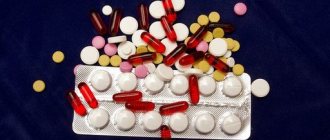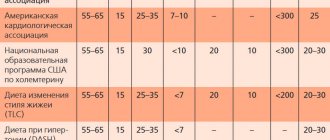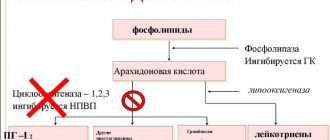Pharmacodynamics and pharmacokinetics
Pharmacodynamics
The antibiotic Cephalexin is a first generation cephalosporin. It disrupts the synthesis of the cell membrane of microorganisms, which leads to their death. Shows activity against streptococci, Escherichia, Proteus, Klebsiel. Activity against Neisseria gonorrhoeae, Shigella spp., Neisseria meningitidis, Salmonella spp. is lower, therefore it is not used in the clinic for diseases caused by these microorganisms.
Ineffective against Enterococcus faecalis Proteus vulgaris, Morganella morganii, Clostridium spp., Pseudomonas aeruginosa. Methicillin-resistant staphylococci are also not sensitive to it.
Destroyed by beta-lactamases secreted by gram-negative microorganisms.
Pharmacokinetics
When taken orally, it is well absorbed and bioavailability is 90–95%. The maximum concentration in the blood is determined after 1 hour, and the required concentration remains for 4–6 hours. 10–15% binds to blood proteins. It is evenly distributed in many tissues and body fluids: it penetrates poorly through the blood-brain barrier and passes through the placenta. Not metabolized. T1/2 is 0.8–1.2 hours. About 89% is excreted and a small part is excreted in bile. If renal function is impaired, the elimination time is prolonged and the concentration increases.
Directions for use and doses
Orally, 30–60 minutes before meals, with water. Adults: 250–500 mg every 6–12 hours for diseases caused by microorganisms sensitive to the drug. For infectious diseases caused by less sensitive microorganisms, the daily dose is 2–4 g. The minimum daily dose is 1 g.
Children are prescribed at a rate of 25–50 (up to 100) mg/kg. Children under 10 years of age are recommended to prescribe the drug in the form of a suspension. The frequency of administration is 4 times a day.
The maximum daily dose for adults and children over 6 years of age is 4 g. The duration of treatment is 7–14 days. For infectious diseases caused by streptococci, the course of treatment is at least 10 days.
Indications for use
- respiratory tract infections: pneumonia , lung abscess , bronchopneumonia , empyema ;
- diseases of the ENT organs: sinusitis , pharyngitis , otitis media , tonsillitis ;
- infection of the genitourinary system: cystitis , pyelonephritis , urethritis , endometritis , prostatitis , gonorrhea , vulvovaginitis ;
- purulent diseases of the skin and tissues: phlegmon , furunculosis , pyoderma , abscess , lymphadenitis ;
- osteomyelitis;
- endometritis;
- gonorrhea.
Nosological classification (ICD-10)
- A54 Gonococcal infection
- H66 Suppurative and unspecified otitis media
- J06 Acute upper respiratory tract infections of multiple and unspecified localization
- L00-L08 Infections of the skin and subcutaneous tissue
- M60.0 Infectious myositis
- M65.0 Tendon sheath abscess
- M65.1 Other infectious tenosynovitis
- M71.0 Abscess of bursa
- M71.1 Other infectious bursitis
- M86 Osteomyelitis
- N30 Cystitis
- N71 Inflammatory diseases of the uterus, except the cervix
- N74.3 Gonococcal inflammatory diseases of the female pelvic organs (A54.2+)
Side effects
- rash , urticaria ;
- Quincke's edema;
- Stevens-Johnson syndrome;
- abdominal pain;
- decreased appetite;
- dry mouth;
- nausea;
- diarrhea;
- cholestasis;
- increased activity of liver transaminases;
- candidiasis of the intestines and oral cavity;
- colitis;
- dizziness;
- headache;
- hallucinations;
- excitation;
- convulsions;
- interstitial nephritis;
- genital candidiasis
- itching of the genitals;
- vaginitis;
- arthralgia;
- leukopenia , thrombocytopenia .
Instructions for use of Cephalexin (Method and dosage)
Cephalexin suspension, instructions for use
Children under 10 years of age are recommended to take the suspension orally. 1 ml of the finished suspension contains 50 mg of cephalexin, and 5 ml 250 mg.
Approximate dose for children:
- up to 1 year - 2.5 ml of suspension 3-4 times a day;
- from 1 year to 3 years - 5 ml 3 times;
- from 3 to 6 years - 7.5 ml 3 times;
- from 6 to 10 years - 10 ml 3 times;
- from 10 years to 14 years - 10 ml 3 times.
In each specific case, the dose and frequency of its administration is specified by the doctor depending on the disease and its severity. In some cases (non-severe skin infections, urinary tract infections, pharyngitis ), the dose is divided into 2 doses, and in severe cases of the disease it is prescribed up to 6 times a day. It is recommended to use the drug for another 2-3 days after clinical improvement.
To prepare the suspension, water is added to the bottle up to the mark on the bottle and shaken. The suspension can be stored at room temperature for 2 weeks. Shake it well before use.
Tablets and capsules are taken orally 30 minutes before meals. The average dose for adults is 250–500 mg every 6 hours, 4 times a day. Thus, the daily dose is 1–2 g (at least), if necessary it is increased to 4 g, which corresponds to the maximum DM for adults, as well as children over 6 years of age. The course of treatment is from 7 to 14 days.
If renal function is impaired, the maximum DM is 1.5 g, divided into 2–4 doses. During treatment, there may be a false positive urine reaction to glucose. It is not recommended to drink alcohol. This drug does not have injection forms (injections), only forms for oral use. A representative of the first generation injectable cephalosporins is Cefazolin , the second generation is Cefuroxime , and in the third generation there are much more of them - Cefotaxime , Ceftriaxone , Cefoperazone , Ceftazidime , Cefoperazone/sulbactam .
Cephalexin (capsules)
Before starting treatment with cephalexin, it is necessary to obtain a detailed history regarding previous hypersensitivity reactions to penicillins, cephalosporins or other substances that cause an allergic reaction in the patient. Patients with a history of allergic reactions to penicillins and carbapenems may have increased sensitivity to cephalosporin antibiotics. If an allergic reaction develops, treatment with the drug should be stopped and appropriate measures taken.
Cases of pseudomembranous colitis have been described when taking antibiotics, the severity of which can vary from mild to life-threatening. Therefore, it is necessary to carry out a differential diagnosis of pseudomembranous colitis in patients with diarrhea that occurs during or after a course of antibiotic treatment. If diarrhea is prolonged or severe or the patient experiences abdominal cramps, treatment with the drug should be stopped immediately and the patient should be examined. Do not use medications that inhibit intestinal motility.
Cases of acute generalized exanthematous pustulosis occurring during treatment with cephalexin have been described. When prescribing the drug, patients should be informed of the signs and symptoms of acute generalized exanthematous pustulosis and closely monitored for skin reactions. If skin reactions characteristic of acute generalized exanthematous pustulosis develop, treatment with cephalexin should be stopped immediately. A significant proportion of cases of acute generalized exanthematous pustulosis were recorded during the first week of therapy.
Long-term use of cephalexin may lead to overgrowth of resistant microorganisms. If superinfections develop during treatment, appropriate measures must be taken.
During treatment with cephalexin, a positive direct Coombs test is possible. When treated with the drug, false-positive results for determining glucose in urine may be observed in tests based on the reduction of copper ions (with Benedict's or Fehling's solutions or with Clinitest tablets).
During the treatment period, it is not recommended to consume ethanol.
In patients with impaired renal function, accumulation is possible (adjustment of the dosage regimen is required).
In staphylococcal infections, cross-resistance exists between cephalosporins and isoxazolylpenicillins.
Cephalexin for children
In pediatric practice, the oral route of drug administration is the main route of administration, as it is the least traumatic. For this, there are special children's forms - syrups and suspensions. Among antibiotics, cephalosporins occupy a leading position because they have a wide spectrum of bactericidal action, are well tolerated, are resistant to beta-lactamases, are easy to dosage, and have rare side effects.
Cephalosporins are an alternative to penicillins in the treatment of respiratory tract and ENT infections. The main area of their use in pediatric practice is not severe infections. Thus, Cephalexin for children is used for tonsillitis , sinusitis , otitis , cervical lymphadenitis , streptococcal or staphylococcal skin infections. It has been noted that penicillins , which are used to treat tonsillitis , are not as effective as cephalosporins, which cause eradication of group A β-hemolytic streptococcus and effective recovery of the child.
Cephalosporins remain in the tissues of the tonsils in bactericidal concentrations, while the concentration of penicillin decreases rapidly. Sinusitis is a common complication of ARVI and occurs in 10% of sick children. For bacterial sinusitis, antibiotics (in this case, cephalosporins are more effective) are a mandatory component of therapy. The suspension can be prescribed to children from birth, but with extreme caution during the first 6 months. The recommended doses are given above, but the doctor, based on the situation, adjusts the dose.
Reviews of Cephalexin
What are Cephalexin tablets for? Since it has antistaphylococcal and antistreptococcal activity, indications for use determine its use for pyelonephritis , cystitis , pneumonia , otitis , pleural empyema , sinusitis , and skin infections.
In reviews of the drug, it is often used for urinary tract infections that do not respond to standard treatment, for example, for recurrent cystitis . It was prescribed to patients in the hospital, after cystoscopies or the use of a catheter, if the patient had diabetes mellitus .
Judging by the reviews, Cephalexin suspension was prescribed to children most often for otitis , tonsillitis , and suspected pneumonia . The suspension has a pleasant fruity smell and does not cause negative emotions in children. Reviews for children are often positive. Mothers note rapid recovery and good tolerability of the drug. Here are some reviews about Cephalexin suspension:
- “... The child had a cough and otitis media. This drug cleared up the fever literally in a day, and after five days we were already healthy”;
- “... My daughter drank it without scandals. She had a sore throat and ear, and had a very high temperature. A day later the condition improved”;
- “... I have an asthmatic child and Cephalexin is our only antibiotic for colds and sore throats. It helps a lot. The suspension is easy to prepare. He drinks it with pleasure, without even washing it down with anything.”
In some cases, stool disturbances were noted, which is associated with the effect of the antibiotic on the intestinal microflora, and nausea.
Cephalexin price, where to buy
You can purchase this drug at any pharmacy. Its cost depends on the manufacturer and form of release. Capsules 500 mg No. 16 can be purchased for about 80 rubles.
Suspension for children is a more convenient form of release for this age category. The price of Cephalexin suspension ranges from 70 rubles.
- Online pharmacies in RussiaRussia
- Online pharmacies in UkraineUkraine
ZdravCity
- Cephalexin capsules 500 mg 16 pcs. Hemomont d.o.o./Hemofarm A.D.
76 RUR order
Pharmacy Dialogue
- Cephalexin capsules 500 mg No. 16Hemofarm
74 RUR order
show more
Pharmacy24
- Cephalexin 250 mg/5 ml 100 ml granules
58 UAH. order - Cephalexin 0.25 No. 20 capsules PAT NEC "Borshchagivsky chemical-pharmaceutical plant", Kiev, Ukraine
37 UAH order
Composition and release form
| Capsules | 1 caps. |
| cephalexin | 250 mg |
| 500 mg |
8 pcs in blister; There are 2 blisters in a box.
| Granules for preparation of suspension for oral administration | 5 ml |
| (prepared suspension) | |
| cephalexin | 250 mg |
in bottles with 40 g of granulate for the preparation of an oral suspension of 100 ml, complete with a dosage spoon; 1 set in box.



